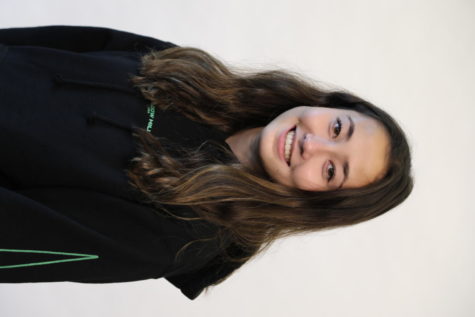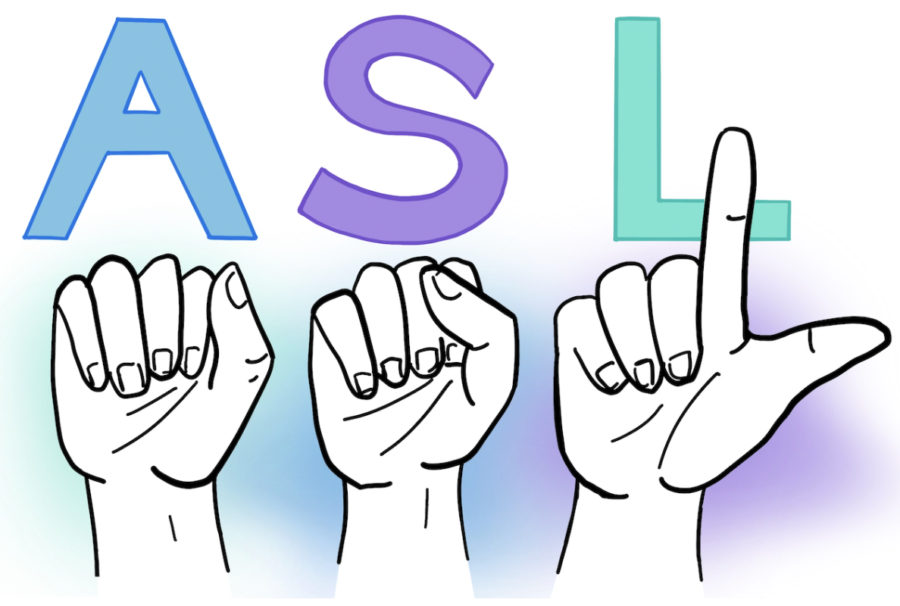At Menlo, Upper School students are required to study a foreign language for a minimum of three years, or until reaching completion of an intermediate course level. While most students opt to learn Spanish, French, Mandarin or Latin, senior Ginger Quigley instead pursued American Sign Language. While Quigley began learning ASL amid the COVID-19 pandemic, unsure of what to expect, she ultimately perceived her experience as worthwhile, and recommends the opportunity to anyone who prefers visual learning.
Quigley was encouraged to take ASL by a close friend before beginning her sophomore year. Even though she was already taking Intermediate Spanish at Menlo, Quigley decided to begin one-on-one online classes at Fusion Academy during her free period. While studying both languages at once, Quigley realized she was able to pick up ASL much more easily, especially since she considers herself a visual learner. “I couldn’t think about Spanish,” she said. “With ASL, it’s kind of just like signing in English, and you can still think in English.”
Several aspects of ASL grammar have also made the language feel easily comprehensible for Quigley. “There aren’t verb tenses,” she noted. “I think that’s usually the hardest thing about learning a language. Conjugating verbs in past, present or future was always hard for me in Spanish, and in ASL, you don’t really have that.”
Additionally, articles and other short English words are completely omitted in ASL, as the language is based on French grammar. “You wouldn’t say, ‘Are you going to the party tomorrow?’ It would be, ‘Tomorrow you going party?’” Quigley said. Consequently, facial expressions are oftentimes crucial in helping others understand the context of a sentence.
According to Quigley, many of her ASL teachers have not been able to speak perfect English, if any at all. “Two of my teachers were hard of hearing, […] and then one of them was deaf,” she said. “When I didn’t really know how to sign, we had to communicate through the chat function in Zoom. Or, when we were in-person, we would be writing things down. As I got better, we kind of used the chat feature less and less, and it was a lot more signing.” Quigley also believes that learning the ASL alphabet was extremely helpful because her teachers could hand-spell out words that were unfamiliar to her. Similar to English, the ASL alphabet is a to z. Words can be spelled out, but lots of words can also be represented by specific hand signals, too.
Still, Quigley emphasizes that her classes are not always totally silent: “Sometimes we do speak,” she said. “But over time, signing felt more normal.”
Many other forms of signing besides ASL also exist. “There isn’t a universal language for every person on earth for every hearing person, so, [for signing], there’s kind of like a different language in each country,” Quigley said. “There’s like Australian Sign Language, British Sign Language, French Sign Language, American Sign Language. It’s all different. I’ve seen BSL, and it is very very different from ASL.” According to Quigley, not everybody understands how different these signing languages actually are, and that they should not be grouped together as the same.
Quigley similarly emphasizes that ASL is not directly a silent version of English. “There is a version of sign language called [Signed English.] That is supposed to be very close to the English language,” she said. “It was a way for deaf kids to learn how to read and write in English through signing.”
Unlike ASL, SE is not seen as adopting the deaf community’s culture, and can instead be perceived as a cause of more harm than good. “[SE] was kind of back when there was more discrimination among deaf people,” Quigley said. According to Quigley, SE does not feel like a natural language or communication system; consequently, ASL is much more common today.
“ASL originated with a lot of culture behind it,” Quigley said. She appreciates ASL because she feels encouraged to not only learn how to sign but also to learn about the entire deaf community’s history. Similar to foreign languages, Quigley’s homework assignments often include reading news articles or watching movie clips — usually with subtitles — about ASL and its various cultures.
“There are so many differences between the hearing culture and deaf culture,” Quigley said. “There are certain things, even like greetings, that are just a bit different.”
According to Quigley, it was especially interesting to learn about the telecommunicator. In modern times, FaceTime allows people to virtually sign with one another, but it was previously difficult for those who were deaf or hard of hearing to communicate online; the telecommunicator was designed to solve this problem, enabling people to pass information over the phone without actually speaking. “You would basically sign to an interpreter, and then they would type [the message] and get it to the other person,” Quigley explained.
Now, Quigley is currently taking ASL classes at Fusion, still via Zoom, and hopes to continue the language next year at the college level. She realized how much she enjoyed ASL when it quickly became a key aspect of her college research; while visiting schools, Quigley recalls asking tour guides and professors about their ASL programs. “A lot of colleges offer it now,” she said. “There’s so much to still learn.”


